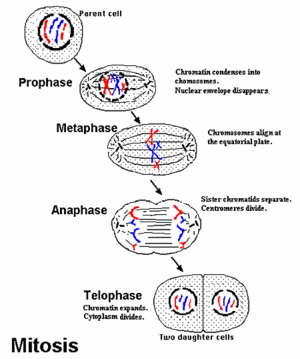Mitosis is the process of cell division that results in two cells identical to the original parent cell. Mitosis is made up of multiple stages that are characterized by the position of the chromosomes inside the cells. Interphase is the stage the cell is in when it is not undergoing mitosis. The cell undergoes normal growth as well as chromosomal replication during interphase.
The first official stage of mitosis is prophase. The chromatin that replicated during interphase now condenses into chromosomes. The nuclear envelope surrounding the genetic material degrades. Two structures called centrosomes cause microtubules in the cell to form a spindle apparatus. As the spindle forms, the centrosomes move to opposite ends of the cell.
After prophase, the next stage of mitosis is prometaphase. The microtubules of the spindle apparatus attach to kinetochores, which are at the midpoint of each chromosome. This allows the chromosomes to later be separated into two chromatids.
The chromosomes are then pulled so that the kinetochores are at the midline of the cell. This is the distinguishing feature of metaphase, making it easy to pick out when viewing cells.
After metaphase, the next phase of mitosis is anaphase. At this point, the chromosomes are lined up on the midline, and each chromosome is made up of two identical sister chromatids. When anaphase begins, the sister chromatids separate. They are then pulled to opposite sides of the cell by the microtubules connected to the kinetochores. This results in the genetic material being separated so two cells can form.
The fifth stage of mitosis is telophase. In telophase, microtubules in the cell lengthen, resulting in an elongated cell. New nuclear envelopes form around the two sets of genetic material. The cell uses the proteins that were degraded from the original nuclear envelope in prophase. The chromosomes change to the loose chromatin form.
While not actually a step in mitosis, the next thing that occurs is cytokinesis. This is the division of the cell into two identical daughter cells. In animal cells, cytokinesis begins with a cleavage furrow that looks like the cell is being pinched in at the metaphase plate.
